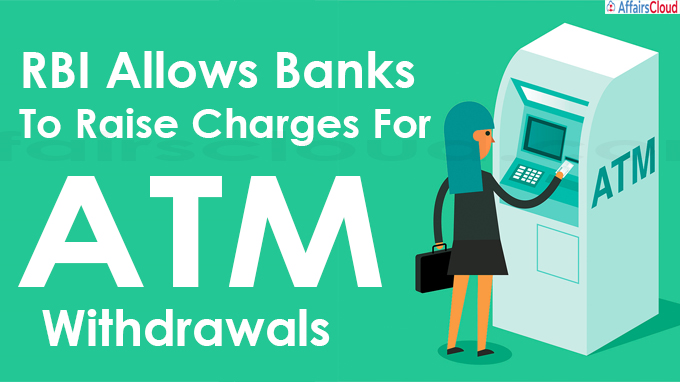 As per the recommendations of the Committee on automated teller machines (ATM) Pricing headed by VG Kannan, under Section 10(2) read with Section 18 of the Payment and Settlement Systems Act, 2007 (Act 51 of 2007), the Reserve Bank of India (RBI) has made certain modifications over the ATM interchange fee, Free transaction limit and Customer charges.
As per the recommendations of the Committee on automated teller machines (ATM) Pricing headed by VG Kannan, under Section 10(2) read with Section 18 of the Payment and Settlement Systems Act, 2007 (Act 51 of 2007), the Reserve Bank of India (RBI) has made certain modifications over the ATM interchange fee, Free transaction limit and Customer charges.
RBI’s Modifications in Brief:
i.Interchange Fee:
RBI has increased the interchange fee that banks could charge on ATM per transaction from Rs 15 to Rs 17 for financial transactions, and from Rs 5 to Rs 6 for non-financial transactions in all centres. This could be effective from August 1, 2021.
ii.Free Transaction Limit:
- RBI enabled the customers eligible to make 5 free transactions (inclusive of financial and non-financial transactions) every month from their own bank ATMs.
- The free transactions limit (inclusive of financial and non-financial transactions) for every month from other bank ATMs is fixed to 3 in metro centres and 5 in non-metro centres.
iii.Customer Charges:
- Customer charges that are applicable to the customers beyond the free transactions were increased by RBI from Rs 20 to Rs 21 per transaction.
- This increase shall be effective from January 1, 2022. This increase was made to compensate banks for higher interchange fees and escalation in costs.
Note – These instructions were made to – All Scheduled Commercial Banks including RRBs /Urban Co-operative Banks / State Co-operative Banks /District Central Co-operative Banks / Authorised ATM Network Operators /Card Payment Network Operators / White Label ATM Operators and to transactions done at Cash Recycler Machines (other than for cash deposit transactions).
Background:
i.RBI had constituted a Committee in June 2019 under the Chairmanship of VG Kannan, the Chief Executive, Indian Banks’ Association to review the entire scope of ATM charges and fees with particular focus on interchange structure for ATM transactions. Click here to know more
ii.The change in interchange fee structure for ATM transactions was last revised in August 2012, and the charges payable by customers were last revised in August 2014.
Key Recommendation of the Committee:
The population as a metric: The committee had recommended using population as a metric for calculating ATM charges, it suggested increasing the free transactions limit at ATMs in all centres based on the two categories – population of less than 1 million (according to Census 2011) and population more than that.
What is an ATM Interchange Fee?
It is the charge paid by the bank that issues the card (issuer) to the bank where it is used to withdraw cash(acquirer). This charge is divided between the acquirer and the company maintaining the ATM.
Key Facts to know:
- In FY21, ATM additions declined to 2,815 against 8,564 in FY20.
- The total number of ATMs across India is 2.13 lakh, in which the number of white label ATMs (which are set up, owned, and operated by non-banks) stood at 25,013.
- ATMs in rural areas account for 20 percent of all ATMs in India.
Recent Related News:
On February 9, 2021 AGS Transact Technologies Ltd (AGSTTL) entered into a partnership with Mastercard to introduce First-Ever ‘Contactless’ Cash Withdrawals on Automated Teller Machines(ATMs) in India. The partnership enables the Mastercard cardholders to withdraw cash at ATMs by scanning the Quick Response(QR) code that is displayed on the ATM screen.
About Automated Teller Machine (ATM):
An ATM is a computerised machine that provides customers of banks the facility of accessing their accounts for dispensing cash and to carry out other financial & non-financial transactions without the need to visit the bank branch.
Types of ATM:
i.White Label ATMs (WLAs): ATMs set up, owned and operated by non-banks (i.e NBFCs) are WLAs. Non-bank ATM operators are authorised under the Payment & Settlement Systems Act, 2007 by RBI.
ii.Green Label ATMs – ATMs for agricultural transactions.
iii.Orange label ATMs – ATMs used for share transactions.
iv.Pink Label ATMs – ATMs that are meant only for women (ease their banking).
v.Yellow Label ATMs – ATMs meant for E-commerce facility.
vi.Brown Label ATMs – ATMs that are outsourced by a bank to a third party (based on the concept of sharing the cost).
vii.Biometric ATM – These are ATMs that use security features like fingerprint scanner and eye scanner of the customer to access the bank details.
viii.Onsite ATMs – ATMs that are located inside the bank’s premises.
ix.Offsite ATMs- ATMs that are located in various places except inside the bank’s premises.




